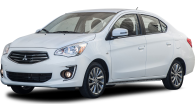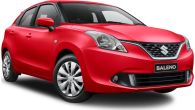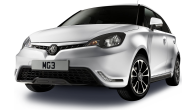The fourth-generation hybrid sheds weight and points to a new breed of clean powertrains.
Toyota's new Prius uses amazingly little fuel, which is probably no surprise. But the real story is the all-new platform it rides on — one that in future can accommodate a new breed of engines.
These engines, powered by hydrogen from an on-board fuel cell, will pair with hybrid technology to emit only water vapour from the exhaust.
The Prius is the first model to be built on the TNGA platform, which is tipped to underpin at least 50 per cent of Toyotas within five years.
Toyota won't comment on future models — but expect the next Prius to be the first mainstream model powered by a fuel cell. Infrastructure may need to catch up as there is now just one hydrogen filling station in Australia.
"This Prius ... is an icon. This is the technology leader for hybrid," says Toyota Australia boss Tony Cramb. "This vehicle makes a statement about the next generation of hybrid technology and what is possible in a hybrid vehicle. It sets the path for the future."
Launched here in 2001, hybrid Prius was originally intended to be a stopgap model. With its small-capacity petrol engine supplemented by the torque from an electric motor, it was a cheap way of reducing fuel consumption and harmful engine emissions.
The emphasis this time around is not on fuel consumption but on making the car more exciting to drive.
The car was designed to fill the gap until the next generation of powertrains arrived, with development of electric and fuel cell vehicles already well under way.
But, almost 15 years later (20 in Japan), we're still waiting for those powertrains and the Prius is showing no signs of going away. In fact, the range has added a smaller hatch and seven-seat version, although the core model remains the most popular.
The Prius, a showcase for Toyota's latest technology, has sold more than 3.6 million sales worldwide, 30,000 in Australia.
Launched this week, the fourth-generation Prius continues to refine the concept. It's lighter, stronger and more dynamic than its predecessor.
{{nid:40013}}
The battery pack has been moved from the back to a position underneath the rear seat, helping to lower the centre of gravity. This has freed up luggage space, but not too much — an additional 12L in the base model and 57L in the more expensive i-Tech.
Why the difference? The base model's space-saver spare still takes up room. The i-Tech's 17-inch wheel won't fit in the boot so it gets an inflation kit — the difference is about three fingers more in depth.
Kicking off from $34,990 ($42,990 for the i-Tech), a $2500 increase on the outgoing model, it is better equipped and uses a frugal 3.4L/100km.
Surprisingly, despite the advances that have been made in this area, the emphasis this time around is not on fuel consumption but on making the car more exciting to drive.
On the road
Toyota has placed a clear emphasis on improving the dynamics and fun factor. The Prius is longer, the centre of gravity is 24mm lower and there is a lower seating position too.
Its chassis, lighter yet 60 per cent stronger, works with new independent, double-wishbone rear suspension to endow greater stability, which means it can corner more quickly.
Punt it hard into a corner and the car exhibits decent grip
Engine power is down 10 per cent to 90kW (the 2.5-litre Camry Hybrid produces 151kW) but you wouldn't know it. That's because the electric motor kicks in earlier and the gearing is more aggressive, adapting to driving styles.
Select "power" mode in the Prius and the adaptive setup adjusts engine braking and throttle response, using feedback from G-sensors.
The regenerative braking has been overhauled and, with a new and quieter active hydraulic booster, has a more natural braking feel.
Slide behind the wheel and the initial impression is that the seats are comfortable, the chunky wheel fits snugly in the hands and the steering is remarkably good. Punt it hard into a corner and the car exhibits decent grip, although the stability control is intrusive.
The question is: why buy a Prius when you can get a cheaper, more practical hybrid Camry or, soon, hybrid Corolla?
It's a view that must be shared by many Aussies because Australia's best-selling hybrid is not the Prius but the Camry, with 5881 sales last year, an increase of 11.2 per cent.
Toyota Prius 2016: Hybrid
| Engine Type | Inline 4, 1.8L |
|---|---|
| Fuel Type | Premium Unleaded/Electric |
| Fuel Efficiency | 3.9L/100km (combined) |
| Seating | 5 |
| Price From | $12,100 - $16,170 |
| Safety Rating |
|
Verdict
Iconic. What's not to like? It uses less fuel and is more engaging to drive. We can't wait for the next fuel cell Prius.
What's new
Price - At $34,990, a $2500 increase on the previous model. For $42,990, the up-spec i-Tech has larger wheels. There is10 per cent less power but you get more for your dough, particularly in technology.
Technology - LED lights with auto high-beam. Inductive phone charging. Head-up display and adaptive cruise control are standard, as is auto braking (down to 15km/h and it's not city friendly), while i-Tech adds blind-spot monitor and rear cross-traffic alert.
Performance - It's a refined version of the 1.8-litre hybrid powertrain. New stiffer chassis and double wishbone rear suspension deliver better ride and handling. Fuel consumption is pruned to a claimed 3.4L/100km.
Driving - To compensate for the reduction in engine output, the electric motor kicks in earlier with more aggressive gearing for greater get up and go off the line. It coasts on electric power only at up to 105km/h.
Design - Lower centre of gravity allowed the nose to be brought down 70mm. Fractionally more luggage space, depending on model, thanks to relocating battery pack under the rear seat.
Check out Malcom Flynn's video review of the 2016 Toyota Prius below.
Would you prefer a Prius over the popular Camry hybrid? Tell us what you think in the comments below.
Click here to see more 2016 Toyota Prius pricing and spec info.
Range and Specs
| Vehicle | Specs | Price* |
|---|---|---|
| Hybrid | 1.8L, Premium Unleaded/Electric, SPEED CONTINUOUS VARIABLE | $12,100 - $16,170 |
| i-Tech Hybrid | 1.8L, Premium Unleaded/Electric, SPEED CONTINUOUS VARIABLE | $14,850 - $19,470 |






.jpg)

.jpg)
.jpg)
.jpg)
.jpg)
.jpg)
.jpg)
.jpg)
_1.jpg)
_0.jpg)
.jpg)
_0.jpg)
_0.jpg)
_0.jpg)
.jpg)
.jpg)
.jpg)
.jpg)

.jpg)
.jpg)
.jpg)
.jpg)
.jpg)
.jpg)
.jpg)
_1.jpg)
_0.jpg)
.jpg)
_0.jpg)
_0.jpg)
_0.jpg)
.jpg)
.jpg)
.jpg)








































.jpg)



.jpg)